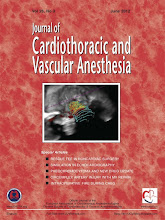Rheumatic Mitral and Aortic Stenosis: To Replace or Not To Replace
That Is the Question—Part 1
Melanie Darke, MD, John Pawloski, MD, Kamal R. Khabbaz, MD, and Feroze Mahmood, MDThe Patient was a 64-year-old woman who presented to her cardiologist with an episode of shortness of breath. She also gave a history of progressive decline in her functional capacity over the last few months. Her chest radiograph showed bilateral pulmonary congestion. Based on her presentation, she was diagnosed as having congestive heart failure and was admitted to the hospital for diuresis and a workup. A transthoracic echocardiogram was done, which showed normal systolic function, moderate mitral stenosis (MS) with a mitral valve area of 1.41 cm2 with a peak gradient of 22 mmHg, and a mean gradient of 9 mmHg. She also had moderate mitral regurgitation and a question of a bicuspid aortic valve and mild aortic stenosis (AS) with peak and mean gradients of 19 and 13 mmHg, respectively. Her cardiac catheterization did not show any coronary artery disease.
Her past medical history was significant for hiatus hernia, hypertension, asthma, and type-2 diabetes mellitus. She had undergone multiple surgeries under general anesthesia in the past without any problems. She was born and grew up in South America, but she did not have a specific history of rheumatic fever. Based on the clinical examination and results of investigations, a diagnosis of rheumatic MS was made, and she was scheduled to undergo an elective mitral valve replacement. She was taking aspirin, enalapril, furosemide, metformin, metoprolol, and sertraline.
On the day of the surgery, she was found to be in sinus rhythm, conscious and alert, and in no apparent respiratory distress. She was 5 feet 1 inch tall and weighed 144 lb. Her hematology and blood chemistry results were with in normal limits. She was taken to the operating room, and, after placement of appropriate monitors, general anesthesia was induced uneventfully and the airway was secured.

Fig 1. A midesophageal 4-chamber view showing
classic diastolic doming of the mitral valve
An intraoperative transesophageal echocardiographic (TEE) examination was performed with an IE-33 ultrasound system with an OMNI-III TEE probe (Philips Medical Systems, Andover, MA).
Presentation 1 (Video A and B): Mitral Valve (Fig 1)
1. Severely thickened and deformed (typical hockey stick deformity)
2. Diastolic bowing of mitral valve and moderate mitral regurgitation.
3. Subvalvular fibrosis and chordal shortening
4. Moderate MS, peak gradient 16 mmHg, and mean gradient 8 mmHg
5. Mitral valve area � 1.32 cm2

Fig 2. A midesophageal short-axis view of the aortic valve during
systolic opening and a planimetered aortic valve area of 1.2 cm2.
Aortic Valve (Fig 2)
1. Trileaflet valve
2. Mildly thickened and retracted
3. Trace aortic regurgitation
4. Left ventricular outflow tract and aortic annulus diameter � 1.8 cm
5. Aortic valve area (AVA) by planimetry 1.32 cm2,by continuity equation 0.97-1.07 cm2; a peak gradient of 16 mmHg was measured with continuous wave Doppler
ECHO CHALLENGES
The aortic valve is considered protected when there is MS because of reduced stroke volume and flow. Hence, it is possible to have a "low" gradient despite significant aortic valvular stenosis because concomitant MS leads to a low stroke volume.
Is this the case in this patient?
If so, then what is the true AVA?
Are clinicians "UNDERESTIMATING" the AS due to mitral stenosis?1
Low gradient is due to low flow (ie, reduced stroke volume and the actual AS is more than moderate; ie, improved stroke volume may worsen the gradient and the severity of AS).
Are clinicians "OVERESTIMATING" the AS due to MS?
AVA is flow dependent, and the small AVA is because of low flow; hence, improvement in stroke volume after mitral valve replacement (MVR) will improve the AVA.
CONFOUNDING VARIABLES
1. Concomitant aortic valve replacement during MVR for rheumatic disease for mild AS is debatable.
2. Is the rheumatic AS severe enough to warrant surgery?
3. Does the progression of rheumatic AS differ from the calcific AS?2
4. If the aortic valve will eventually require surgery, are the risks of a redo aortic valve replacement more or less than mitral and aortic valves being replaced simultaneously?
1. Concomitant aortic valve replacement during MVR for rheumatic disease for mild AS is debatable.
2. Is the rheumatic AS severe enough to warrant surgery?
3. Does the progression of rheumatic AS differ from the calcific AS?2
4. If the aortic valve will eventually require surgery, are the risks of a redo aortic valve replacement more or less than mitral and aortic valves being replaced simultaneously?
REFERENCES
1. Zitnik RS, Piemme TE, Messer RJ, et al: The masking
of aortic stenosis by mitral stenosis. Am Heart J 69:22-30,
1965
2. Choudhary SK, Talwar S, Juneja R, et al: Fate of mild aortic
valve disease after mitral valve intervention. J Thorac Cardiovasc
Surg 122:583-586, 2001

